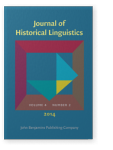Vol. 4:2 (2014) ► pp.192–231
Explaining tense marking changes in Swedish verbs
An application of two analogical computer models
This study investigates the role of analogy in the changes in inflectional classes of Swedish verbs from the Old Swedish to Modern Swedish period. Verbs in the Germanic languages are generally classed as either weak or strong according to their type of inflection, but closer examination reveals interesting subtleties and exceptions to this general picture. Furthermore, changes in inflectional class go in different directions: not only from strong to weak, but also the other way around, and between strong classes and weak classes. Two analogical computer models — Analogical Modeling (Skousen 1989) and Minimal Generalization (Albright & Hayes 2002) — are used to model a selection of 80 such changes in the history of Swedish verbs. Taking only phonological descriptions of present tense verb stems paired with their original past tense stems as input, the models attempt to predict the most likely past tense forms based on analogy. In the cases where the new outcome matches the actual changes in Swedish, the predictions are considered correct. In this way, both models predicted roughly half of all changes correctly, but 83% of the changes where a weak verb became strong. I conclude that analogy modeled in this way may play a moderate to strong role in inflection class change in general, but a particularly strong role in the case of new strong verbs. Based on these results, analogy is deserving of a revaluation as an explanatory force in diachronic linguistics.
